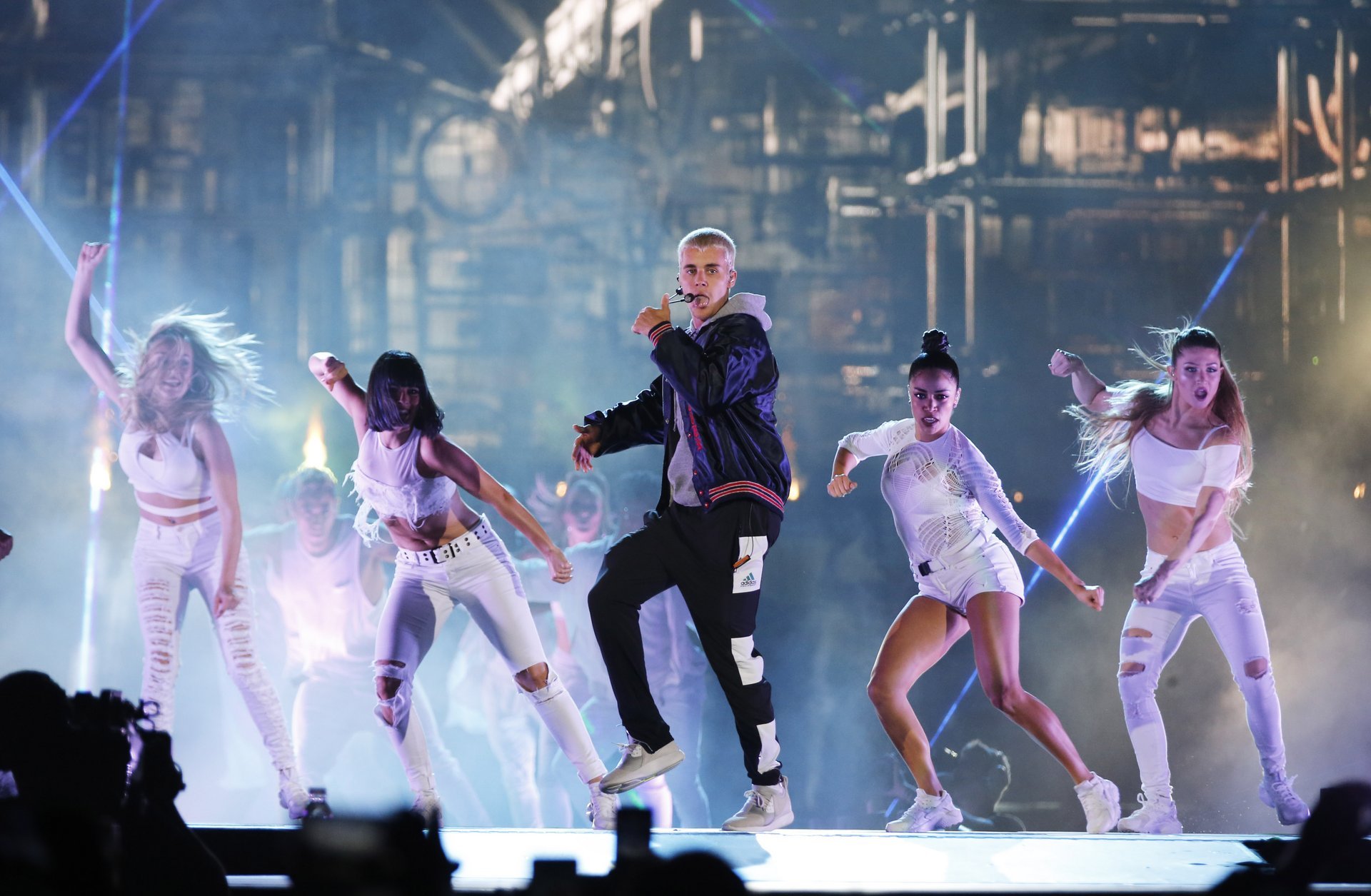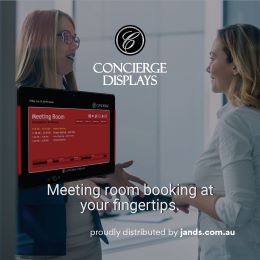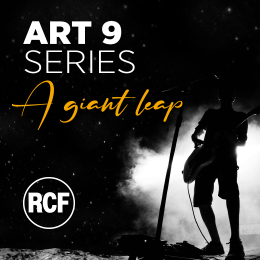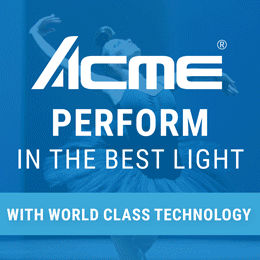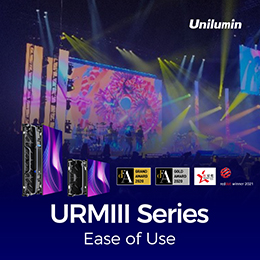Subscribe to CX E-News
By Cat Strom
After a year of touring the world with his Purpose arena show, Justin Bieber began a run of stadium shows in Australia, shows that will continue through the rest of the year.
Kenneth ‘Pooch’ Van Druten built his reputation as a FOH sound mixer with bands such as KISS, Kid Rock, Linkin Park, Guns & Roses, System of a Down and Limp Bizkit. Bieber is a noticeable departure from his usual clients.
“Pop tours are the bigger tours these days so guys like me, who have experience with large stadium shows, are getting asked to do pop stuff,” he explained.
The PA was all Meyer Leo and Lyon systems, along with some Milo for delays, provided by VER in partnership with Norwest Productions. The main hangs and the outside hangs were Leo boxes with Lion boxes on the very outside and for the delay tower, as well as the stadium ring, were Milo and Lyon.
“The Lyon is just fantastic and perfect for this kind of show,” commented Kenneth. “The main reason is that it is a two-way box, as opposed to a three-way box, so there are basically low end drivers and then there is a horn that covers all the wave frequencies upwards. What happens with a three-way box is that often the crossover between the mid-point and the high point is a difficult place for vocal and some instruments. The Lyon, being a two-way box, is super smooth in all of that area. Everybody is coming to hear Justin Bieber so his vocals have got to be stellar and this PA does that. His vocal is right up in front, and the rest of it is really nice too, but it’s important that everyone can hear what he sings and says.
Kenneth admits that Justin has quite a soft voice and that there are times when he sings low and that’s probably the hardest part of his job.
“When he’s 150ft in front of the PA and not talking or singing very loud, getting him over the top of the band is the most difficult part of my job.”
The system guys worked all night to ensure that everything was aligned and time delayed correctly, walking the entire venue to ensure it all sounds good.
“We really pay attention to the fact that people pay a lot of money to come in here and we work really hard to ensure that, no matter where you’re siting, you all get the same show,” said Kenneth. “During the show, my system engineer John Kaler walks the entire venue making adjustments if required on a wireless tablet. There are a lot of zones in a stadium and where those zones meet is the difficult part.”
Kenneth mixes on a DiGiCo SD7 saying he favours the super transparency of the front end.
“Whatever mic choices you make in front of something there’s no colouration,” he said. “You can be really specific about mic choices that you make specific to a specific instrument without having to worry that your console is going to colour that. It’s like having a palette that is transparent, when you put a blue on it it’s really blue.”
The second best thing about the DiGiCo SD7 for Kenneth is the way it utilises Waves plugins, allowing him to do a bunch of Waves stuff within the console. Kenneth said the flexibility of the console is what makes it truly amazing; you can have tons of inputs, tons of outputs …. basically if you can imagine it, you can do it with this console.
“I utilise the Waves stuff kind of old school, as if it were a big outboard rack of analogue gear,” he explained. “I don’t put Waves stuff on everything, I utilise it very sparingly compared to some other engineers. I haven’t run up against anything with the Waves stuff that I don’t like. I do have some outboard gear such as three Bricasti reverb, a Lexicon PCM96 and Anteler word clock. For speaker management use a Waves eMotion LV1 Live Mixer, and for record, I use a Mac mini with Waves DiGiGrid MGB.
“Managing Justin wherever he is in a speaker zone, depending on where he is and how loud he is speaking, there’s a bit of EQ management that has to happen so I’m on my toes. I have a video feed in my console of a close shot of Justin so I can really watch him as he sings. If he pulls the mic away and accidently points at something with it, I can see it and pull it very quickly.”
The majority of microphones are Telefunkin with Justin’s vocal a Telefunkin capsule on a Shure transmitter. A lot of the drum mics are Telefunkin but Royer ribbon mics are used on guitar.
MONITORS
“Everyone on stage, including the dancers, are on IEMs,” said Alex McCloud, who has done monitors for Justin the past five years. “We have twenty-four dancers all on the same mix mainly so they can get cues from the choreographer via a talkback system that we have. I’ve built them a really good left / right mix that they listen to, they never really ask for anything, it’s pretty much what we give them.”
The band are all on Jerry Harvey Roxannes with the dancers on a cheaper JH3 moulds and most of the techs on JH16 moulds.
“I use a simpler mould for Justin as we don’t need anything really fancy,” commented Alex. “I find with singers, if I use a fancy mould I end up EQ-ing a lot of stuff out. If I use a mould that has less driver information in it, I tend to leave a lot of that EQ information in getting a flatter response out of the mix. I have Justin of JH11’s and then I reference the show with JH11’s. I built everything in rehearsals off of the Roxannes for the band mainly, but once I got Justin into the picture, I went to the JH11’s. I’ve had him on JH11’s for years now and it just works for him. I find him not messing with his moulds much and leaving them in 95% of the time.”
There were a handful of wedges on the show; local sidefills in Sydney consisting of six Meyer Lyon M’s per side, 80 degree version. A bunch of d&b M2’s are toured with a couple on the downstage line to help fill the stage in case Justin or one of the dancers pull an IEM out. The drummer had a Meyer 900 drum sub, the bass player a d&b V-Sub and an MQ wedge and the DJ had an MQ wedge plus Alex also had an MQ wedge.
Alex was also mixing on a DiGiCo SD7 running three full SD racks plus a mini rack and also had an SD11 in the loop for opening acts.
“I have Whirlwind splits so Pooch has his own set of racks and I have my own set of racks, so gain wise we’re completely independent,” he revealed. “It was a choice that I made really early on with Bieber; to get independent control from FOH because both of our systems are so elaborate. By the time you start adding all those racks into the opticore loop plus two consoles, you tend to have quite a few issues so I chose to do it that way and we don’t have any issues.”
Alex was pretty active during the show as he was very hands on with Justin who, depending on his mood, may use headset or hand held. If he’s doing headset, he also has IEMs on constantly so it ends up being two packs with cables down his back and things can go wrong. Alex always has spares ready at all times.
“With 140 inputs going on onstage, it’s good that I have quite an elaborate talkback system consisting of 22 channels of talkbacks on stage which gives us all really good communication,” he said. “Everyone onstage is in the loop at all times, if we need to stop the show everyone knows, if I need to communicate with just the techs I have the ability to switch and do that.”
LIGHTING
Lighting director Nick van Nostrand has been working for Bieber’s management on a variety of projects such as Ariane Grande for a few years, although he is freelance. He explained that the lighting design has changed quite drastically from the arena tour.
“The arena show came out over the audience quite a lot with a big trampoline structure that was pretty dominant,” he said. “Obviously in stadiums you’re limited as to what you can hang in the roof structure so the trampoline had to go and we built a thrust stage with a bunch of lifts to give a variety of effects to the show. We also beefed up the pyros and lasers.”
Some of the key pieces of lighting equipment required was toured, as were lights built into the video wall and the Ayrton VersaPix hanging on the front of the trusses, but 90% was sourced locally from PRG.
Six fingers of truss mid-stage held seven Ayrton VersaPix on the front as well as three wash lights (in Australia they were GLP impression X4’s) and three Sharpy-type beam lights (actual Claypaky Sharpys in Australia). Upstage were four angled trusses again with seven Versapix and four Sharpy-type beams and a washlight on either end. Side trusses had more impression X4’s for side light.
Around the video wall there were Ayrton MagicBlades whilst the downstage truss held a bunch of Vari-lite VL3500 washes, more VersaPix and also TMB Solaris Flares. Cory Fitzgerald, the lighting designer for the show, is a big fan of the Solaris Flares.
On the wings there were Sharpy Washes, twelve on each truss of the three trusses per side so a total of thirty-six per side. Each of those trusses also held six strobes and four blinders. Around the thrust there was a combination of more impression X4’s, Sharpys and for dancer lights pointing in at the thrust, Philips Color Kinetics ColorReach or Solaris Flares.
At the C stage there was an octagon-shaped lift that rises and this was clad all the way around in PRG video panels. Inside the octagon were forty TMB Mozarts for internal lighting. Delay towers have more Sharpy Washes and a bunch of Martin Atomics to help make the audience sitting far away from the stage feel closer to the action.
Cory and Nick spent time in Los Angeles trying to convert some of the arena files over to the stadium version, Nick did some more 3D work but the first time they actually saw it up and running was the Perth show.
“It’s drastically different fixtures to what we had in the arena show where we had a lot of Claypaky B-Eyes and Mythos, so there were parts of the show that had to be simplified and modified just to fit with what we could get our hands on, but I think it has turned out very well,” commented Nick. “The biggest challenge so far on these stadium shows is the advance and that probably consumes 90% of my time. Getting quantity of fixtures we need, especially when we get into South America, is very difficult. We need 220 wash lights but finding a vendor who has 220 of anything is basically next to impossible.”
Control was by two MA Lighting grandMA2, one as a tracking backup, with fibre snake to the stage and the NPUs and Nodes for all of toured equipment is also toured with the local vendor supplying NPU’s for their equipment. The show was all time coded.
“It was raining in Sydney so a fair amount of gear was set up last minute meaning we started the show without being able to focus some lights,” said Nick. “They were roughly in the right first position but I needed to tweak them as the show progressed.”
Four follow spots were positioned out front with two Robe BMFL truss spots in the rig controlled by Nick.
“Australia was a good place to start the tour as we weren’t putting the rig up every day and had time to fix things.”
Subscribe
Published monthly since 1991, our famous AV industry magazine is free for download or pay for print. Subscribers also receive CX News, our free weekly email with the latest industry news and jobs.


